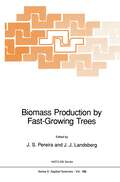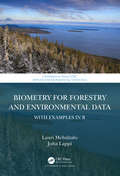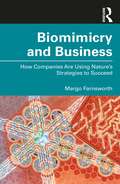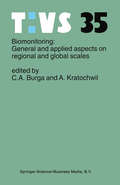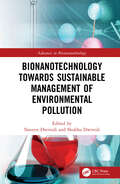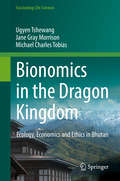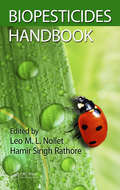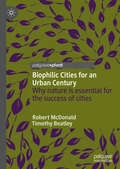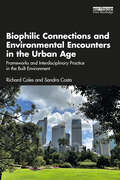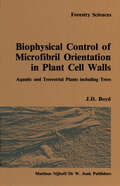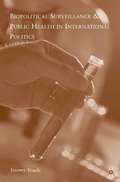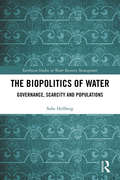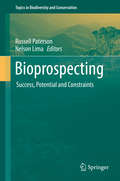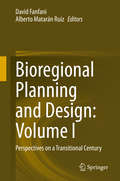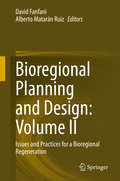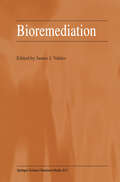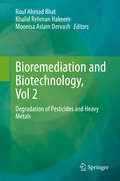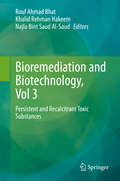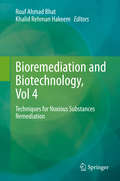- Table View
- List View
Biomass Production by Fast-Growing Trees (NATO Science Series E: #166)
by J. S. Pereira J. J. LandsbergEven though most of the biomass of the planet is in forests, we live in a world where wood as a raw material and its products are increasingly scarce. This is particularly so in important areas such as the European Community, which is far from self-sufficient in terms of wood. In recent years the need to intensify forest production and, in some cases, to uti lize abandoned agricultural land for forestry has focussed world-wide attention on the economic importance of fast-growing tree plantations. These are usually managed as short "rotations" (growing cycles) of less than 15 years, often for the production of industrial raw materials or biomass for energy. Under the designation of fast-growing tree plantations, or short rotation silviculture, one may find ecosystems managed for different economic objectives, with different intensities of technical intervention and different levels of productivity. They may include any of a wide range of species grown under various environmental conditions. A common factor, however, is the greater possibility that exists, relative to conventional forestry, for manipulation of both the environment and the genetics of the trees.
Biometry for Forestry and Environmental Data: With Examples in R
by Lauri MehtataloBiometry for Forestry and Environmental Data with Examples in R focuses on statistical methods that are widely applicable in forestry and environmental sciences, but it also includes material that is of wider interest. Features: · Describes the theory and applications of selected statistical methods and illustrates their use and basic concepts through examples with forestry and environmental data in R. · Rigorous but easily accessible presentation of the linear, nonlinear, generalized linear and multivariate models, and their mixed-effects counterparts. Chapters on tree size, tree taper, measurement errors, and forest experiments are also included. · Necessary statistical theory about random variables, estimation and prediction is included. The wide applicability of the linear prediction theory is emphasized. · The hands-on examples with implementations using R make it easier for non-statisticians to understand the concepts and apply the methods with their own data. Lot of additional material is available at www.biombook.org. The book is aimed at students and researchers in forestry and environmental studies, but it will also be of interest to statisticians and researchers in other fields as well.
Biometry for Forestry and Environmental Data: With Examples in R
by Lauri MehtataloBiometry for Forestry and Environmental Data with Examples in R focuses on statistical methods that are widely applicable in forestry and environmental sciences, but it also includes material that is of wider interest. Features: · Describes the theory and applications of selected statistical methods and illustrates their use and basic concepts through examples with forestry and environmental data in R. · Rigorous but easily accessible presentation of the linear, nonlinear, generalized linear and multivariate models, and their mixed-effects counterparts. Chapters on tree size, tree taper, measurement errors, and forest experiments are also included. · Necessary statistical theory about random variables, estimation and prediction is included. The wide applicability of the linear prediction theory is emphasized. · The hands-on examples with implementations using R make it easier for non-statisticians to understand the concepts and apply the methods with their own data. Lot of additional material is available at www.biombook.org. The book is aimed at students and researchers in forestry and environmental studies, but it will also be of interest to statisticians and researchers in other fields as well.
Biomimicry and Business: How Companies Are Using Nature's Strategies to Succeed
by Margo FarnsworthBiomimicry, the practice of observing then mimicking nature’s strategies to solve business challenges, offers a path to healthy profit while working in partnership, and even reciprocity, with the natural world. Other books have described biomimicry, its uses, and its benefits. This book shows readers how to create their own biomimetic or bioinspired solutions with clear benefits to the bottom line, the environment, and people. Fashioned through storytelling, this book blends snapshots of five successful companies – Nike, Interface, Inc., PAX Scientific, Sharklet Technologies, and Encycle – which decided to partner with nature by deploying biomimicry. The book details how they discovered the practices, introduced them to staff, engaged in the process, and measured outcomes. The book concludes with challenges for readers to determine their own next steps in business and offers practical and useful resources to get there. By revealing the stories of each professional’s journey with lessons they learned, then providing resources and issuing a challenge and pathway to do business better, this book serves as a tool for entrepreneurs, seasoned professionals, and students to emulate nature’s brilliance, apply it at work, and contribute to a healthier, more prosperous world.
Biomimicry and Business: How Companies Are Using Nature's Strategies to Succeed
by Margo FarnsworthBiomimicry, the practice of observing then mimicking nature’s strategies to solve business challenges, offers a path to healthy profit while working in partnership, and even reciprocity, with the natural world. Other books have described biomimicry, its uses, and its benefits. This book shows readers how to create their own biomimetic or bioinspired solutions with clear benefits to the bottom line, the environment, and people. Fashioned through storytelling, this book blends snapshots of five successful companies – Nike, Interface, Inc., PAX Scientific, Sharklet Technologies, and Encycle – which decided to partner with nature by deploying biomimicry. The book details how they discovered the practices, introduced them to staff, engaged in the process, and measured outcomes. The book concludes with challenges for readers to determine their own next steps in business and offers practical and useful resources to get there. By revealing the stories of each professional’s journey with lessons they learned, then providing resources and issuing a challenge and pathway to do business better, this book serves as a tool for entrepreneurs, seasoned professionals, and students to emulate nature’s brilliance, apply it at work, and contribute to a healthier, more prosperous world.
Biomonitoring: General and Applied Aspects on Regional and Global Scales (Tasks for Vegetation Science #35)
by Conradin A. Burga Anselm KratochwilBionanotechnology Towards Sustainable Management of Environmental Pollution (Advances in Bionanotechnology)
by Naveen Dwivedi Shubha DwivediThis book highlights the characteristics, aims, and applications of bionanotechnology as a possible solution for sustainable management and bioremediation of environmental pollutants. It covers remediation of toxic pollutants, removal of emerging contaminants from industrial wastewater, eco-design and modification study of bio-nanoparticles and life-cycle assessment, nano-filtration, bio-nanomaterials based sensors for monitoring air and water pollution, resource recovery from wastewater, and highlights Internet of things-based green nanotechnology.Provides a comprehensive solution of environmental problems in sustainable and cost-effective modeReviews bionanotechnological applications in nanomaterials design, modification, and treatment of emerging contaminants from industrial wastewater.Covers Eco-design study of bio-nanomaterials, bio-nano filters, and assessment for the treatment of emerging pollutantsIncludes IoT- based bionanotechnologyExplores future research needs on bionanotechnology and scientific challenges in the mitigation of environmental pollutantsThis book is aimed at researchers, professionals, and graduate students in nanobiotechnology, environmental engineering, biotechnology.
Bionanotechnology Towards Sustainable Management of Environmental Pollution (Advances in Bionanotechnology)
by Naveen Dwivedi Shubha DwivediThis book highlights the characteristics, aims, and applications of bionanotechnology as a possible solution for sustainable management and bioremediation of environmental pollutants. It covers remediation of toxic pollutants, removal of emerging contaminants from industrial wastewater, eco-design and modification study of bio-nanoparticles and life-cycle assessment, nano-filtration, bio-nanomaterials based sensors for monitoring air and water pollution, resource recovery from wastewater, and highlights Internet of things-based green nanotechnology.Provides a comprehensive solution of environmental problems in sustainable and cost-effective modeReviews bionanotechnological applications in nanomaterials design, modification, and treatment of emerging contaminants from industrial wastewater.Covers Eco-design study of bio-nanomaterials, bio-nano filters, and assessment for the treatment of emerging pollutantsIncludes IoT- based bionanotechnologyExplores future research needs on bionanotechnology and scientific challenges in the mitigation of environmental pollutantsThis book is aimed at researchers, professionals, and graduate students in nanobiotechnology, environmental engineering, biotechnology.
Bionomics in the Dragon Kingdom: Ecology, Economics and Ethics in Bhutan (Fascinating Life Sciences)
by Ugyen Tshewang Jane Gray Morrison Michael Charles TobiasThis compact and elegant work (equally fitting for both academic as well as the trade audiences) provides a readily accessible and highly readable overview of Bhutan’s unique opportunities and challenges; all her prominent environmental legislation, regulatory statutes, ecological customs and practices, both in historic and contemporary terms. At the same time, Bionomics places the ecological context, including a section on animal rights in Bhutan, within the nation’s Buddhist spiritual and ethical setting. Historic contextualization accents the book’s rich accounting of every national park and scientific reserve, as well as providing up-to-the-minute climate-change related hurdles for the country.Merging the interdisciplinary sciences, engineering and humanities data in a compelling up-to-date portrait of the country, the authors have presented this dramatic compendium against the backdrop of an urgent, global ecological time-frame. It thus becomes clear that the articulated stakes for Bhutan, like her neighboring Himalayan and Indian sub-continental countries (China, India, Bangladesh and Myanmar) are immense, as the Anthropocene epoch unfolds, affecting every living being across the planet. Because Bhutan’s two most rewarding revenue streams derive from the sale of hydro-electric power and from tourism, the complexities of modern pressures facing a nation that prides herself on maintaining traditional customs in what has been a uniquely isolated nation are acute.
Biopesticides Handbook
by Leo M. L. Nollet Hamir Singh RathoreThe need to feed an ever-growing global population combined with increasing demand for sustainable agricultural practices has generated a significant rise in demand for biopesticides. By responding concurrently to the interests of farming, forestry, and industrial sectors, biopesticides offer a considerable potential for utilization in sustainable
Biopesticides Handbook
by Leo M. L. Nollet Hamir Singh RathoreThe need to feed an ever-growing global population combined with increasing demand for sustainable agricultural practices has generated a significant rise in demand for biopesticides. By responding concurrently to the interests of farming, forestry, and industrial sectors, biopesticides offer a considerable potential for utilization in sustainable
Biophilic Cities for an Urban Century: Why nature is essential for the success of cities
by Robert McDonald Timothy BeatleyThis book argues that, paradoxically, at their moment of triumph and fastest growth, cities need nature more than ever. Only if our urban world is full of biophilic cities will the coming urban century truly succeed. Cities are quintessentially human, the perfect forum for interaction, and we are entering what could justly be called the urban century, the fastest period of urban growth in human history. Yet a growing body of scientific literature shows that the constant interaction, the hyper-connectedness, of cities leads to an urban psychological penalty. Nature in cities can be solution to this dilemma, allowing us to have all the benefits of our urban, connected world yet also have that urban home be a place where humanity can thrive. This book presents best practices and case studies from biophilic design, showing how cities around the world are beginning to incorporate nature into their urban fabric. It will be a valuable resource for scholars and professionals working in the area of sustainable cities.
Biophilic Connections and Environmental Encounters in the Urban Age: Frameworks and Interdisciplinary Practice in the Built Environment
by Richard Coles Sandra CostaBiophilic Connections and Environmental Encounters in the Urban Age takes a multi-disciplinary approach, drawing on the authors’ wide range of experience, to provide a greater understanding of the different dimensions of environmental engagement. It considers the ways that we interact with our environments, presenting a comprehensive account of how people negotiate and use the urban landscape. Set within current debates concerning urban futures, societal issues, sustainable cities, health and well-being, the book explores our innate need for contact with the natural world through biophilic design thinking to expand our knowledge base and promote a wider understanding of the importance of these interactions on our collective well-being. It responds to questions such as, what are the urban qualities that support our well-being? As an urbanised society what are the environmental determinants that promote healthy and satisfying lifestyles? Beginning with an overview of concepts relating to biophilia and environmental engagement, it moves through current theory and practice, different pathways and their characteristics, before presenting real world examples and applications through illustrated case studies in different world situations. With a particular focus on the experience of individuals, the book is essential reading for students, researchers, and practitioners of architecture, landscape architecture, urban planning, design and health sciences, interested in the future of our cities and the importance of green spaces.
Biophilic Connections and Environmental Encounters in the Urban Age: Frameworks and Interdisciplinary Practice in the Built Environment
by Richard Coles Sandra CostaBiophilic Connections and Environmental Encounters in the Urban Age takes a multi-disciplinary approach, drawing on the authors’ wide range of experience, to provide a greater understanding of the different dimensions of environmental engagement. It considers the ways that we interact with our environments, presenting a comprehensive account of how people negotiate and use the urban landscape. Set within current debates concerning urban futures, societal issues, sustainable cities, health and well-being, the book explores our innate need for contact with the natural world through biophilic design thinking to expand our knowledge base and promote a wider understanding of the importance of these interactions on our collective well-being. It responds to questions such as, what are the urban qualities that support our well-being? As an urbanised society what are the environmental determinants that promote healthy and satisfying lifestyles? Beginning with an overview of concepts relating to biophilia and environmental engagement, it moves through current theory and practice, different pathways and their characteristics, before presenting real world examples and applications through illustrated case studies in different world situations. With a particular focus on the experience of individuals, the book is essential reading for students, researchers, and practitioners of architecture, landscape architecture, urban planning, design and health sciences, interested in the future of our cities and the importance of green spaces.
Biophysical control of microfibril orientation in plant cell walls: Aquatic and terrestrial plants including trees (Forestry Sciences #16)
by J.D. BoydWithin the extreme diversity of aquatic and terrestrial plant genera, each has characteristic cell wall forms. A number of hypotheses have been advanced to explain differences in microfibril arrangements across anyone such wall. Of those, only the 'multinet' theory, which involves the postulation of reorientation of microfibrils caused by cell extension, now has a substantial number of ad herents. However, many scientists are sceptical of its validity; obviously it is incompatible with various observed microfibril arrangements. The tenet of this study is that any such hypothesis can be valid only if it is applicable to all plant forms and wall types. Initially, reanalyses are made of data claimed to confirm justification for multi net postulations. The results show that previous deductions from those data, in support of multinet, are subject to serious challenge. Similarly, a re-examination of the observations, which inspired the multinet theory, shows they have a more logical explanation. Herein, it is concluded that cell wall development involves biophysical factors, which neces sarily prevent multinet's postulated large reorientations of microfibrils, after their formation. Unfortunately the previously most recent published theory, which is based on the absence of reorientation during extension, fails to answer the fundamental question of how alternating orientations between lamellae are controlled, or explain variations in thickness of wall layers. Extensive published data are used to identify forces involved in cell wall development.
Biopolitical Surveillance and Public Health in International Politics
by J. YoudeUsing historical and contemporary case studies, Youde traces the shifting balance between surveillance and global public good provision and suggests that a human rights-based strategy offers a stable compromise.
The Biopolitics of Water: Governance, Scarcity and Populations (Earthscan Studies in Water Resource Management)
by Sofie HellbergBiopolitics refers to a form of politics concerned with administering and regulating the conditions of life at an aggregated level of populations. This book provides a biopolitical perspective on water governance and its effects. It draws on the work of Foucault to explore how notions of scarcity are used in strategies of governance and how such governance differentiates between different populations. Furthermore, the author investigates what such biopolitical regulation means for people’s lifestyles and the way they understand themselves and their moral responsibilities as humans, individuals and citizens. The book begins by investigating the global water agenda, with a particular emphasis on its focus on water for basic needs, and provides different examples of hydromentalities around the world. It also presents rich empirical details of one local case in South Africa. By carefully exploring the water 'stories' of water users, the book provides new perspectives on the relationship between water and power. Additionally, it offers an innovative methodological framework through which we can study the workings of governance more generally, and water governance specifically. It thereby contributes to the scholarship on water governance in relation to how water governance and technologies are part of producing subjectivities, notions of life and lifestyles and, more specifically, how the global water agenda can work so as to produce, or further entrench, distinctions between different lives and lifestyles. Ultimately, such differences between individuals and populations that are produced as an effect of water governance are assessed in relation to social sustainability.
The Biopolitics of Water: Governance, Scarcity and Populations (Earthscan Studies in Water Resource Management)
by Sofie HellbergBiopolitics refers to a form of politics concerned with administering and regulating the conditions of life at an aggregated level of populations. This book provides a biopolitical perspective on water governance and its effects. It draws on the work of Foucault to explore how notions of scarcity are used in strategies of governance and how such governance differentiates between different populations. Furthermore, the author investigates what such biopolitical regulation means for people’s lifestyles and the way they understand themselves and their moral responsibilities as humans, individuals and citizens. The book begins by investigating the global water agenda, with a particular emphasis on its focus on water for basic needs, and provides different examples of hydromentalities around the world. It also presents rich empirical details of one local case in South Africa. By carefully exploring the water 'stories' of water users, the book provides new perspectives on the relationship between water and power. Additionally, it offers an innovative methodological framework through which we can study the workings of governance more generally, and water governance specifically. It thereby contributes to the scholarship on water governance in relation to how water governance and technologies are part of producing subjectivities, notions of life and lifestyles and, more specifically, how the global water agenda can work so as to produce, or further entrench, distinctions between different lives and lifestyles. Ultimately, such differences between individuals and populations that are produced as an effect of water governance are assessed in relation to social sustainability.
Bioprospecting: Success, Potential and Constraints (Topics in Biodiversity and Conservation #16)
by Russell Paterson Nelson LimaThis book considers all aspects of bioprospecting in 14 succinct chapters and a forward by David Hawksworth. The organisms addressed include plants, insects, fungi, bacteria and phages. Bioprospecting has never been more relevant and is of renewed interest, because of the extremely worrying rise in novel, resistant pathogenic microorganisms. The practices in pharmaceutical companies have failed to deliver novel antibiotics to control these infections. We need to look for new sources of drugs from the environment on a massive scale as drug discovery is “too important to fail”. Furthermore, the field can add great value to ecosystems in terms of economics, while providing additional reasons for maintaining associated services, such as food provision, benign climate, effective nutrient cycling and cultural practices. Bioprospecting provides another reason why climate change must be reduced in order to preserve relevant environments. Previous bioprospecting projects should be re-visited and established biodiversity centres have a major role. Many different ecosystems exist which contain unique organisms with the potential to supply novel antibiotics, enzymes, food, and cosmetics, or they may simply have aesthetic value. The book stresses the difficulties in obtaining successful products and yet describes why natural products should be investigated over combinatorial chemistry. Personal experience of bioprospecting projects are given significance. Issues such as how to share the benefits equitably with local communities are described and why pharmaceutical companies can be reluctant to be involved. Legal issues are discussed. Finally, there has never been a better time for a new book on bioprospecting, because of the need to preserve ecosystems, and from the emergence of resistant pathogenic microorganisms.
Bioregional Planning and Design: Perspectives on a Transitional Century
by David Fanfani Alberto Matarán RuizThis book provides a review of the bioregionalist theory in the field of spatial planning and design as a suitable approach to cope with the growing concerns about the negative effects of metropolization processes and the need for a sustainable transition. The book starts out with a section on rethinking places for community life, and discusses the reframing of regional governance and development as well as social justice in spatial planning. It introduces the concept of the urban bioregion, a pivotal concept that underpins balanced polycentric spatial patterns and supports self-reliant and fair local development. The second part of the book focuses on planning, and particularly on the issues that arise from the ‘circular’ recovery of the relation between city and agro-ecosystems for integrated planning and resilience of settlements and discusses topics such as foodshed planning, biophilic urbanism and the integration of rural development and spatial planning. This volume sets out the reference framework for Volume II which deals with more specific and operational issues related to spatial policies and settlement design.
Bioregional Planning and Design: Issues and Practices for a Bioregional Regeneration
by David Fanfani Alberto Matarán RuizThis book provides insights and discusses the practical application of the theoretical concept of urban bioregion complementing the general bio-regional planning cross-disciplinary issues provided in Volume I. It examines planning practices, such as relocalisation of energy flows, land protection for climate change, territorial heritage enhancement, the consideration of urban ecosystems and agro-ecology. It presents discussions on regional contexts, practices and projects for a bioregional recovery, and includes case studies from France, Belgium, Spain, Greece, Austria and Italy, discussing topics that range from the reframing of local energy production/delivery planning systems to soil protection and farmland sustainable exploitation schemes. This volume concludes with three cross-European case studies that make clear the worldwide relevance and potential of bioregional approach beyond the Global North or Western countries.
Bioremediation
by James J. ValdesIn the field of biosensors the previous focus has been almost entirely on medical diagnostics. Here it is discussed in relation to bioremediation. The application of new biosensing techniques to environmental monitoring promises to be a more economical approach to monitoring both soil consortia and levels of pollutants. Significantly, functional biosensors can determine such parameters as`How clean is clean?' This new edition is targeted specifically at graduate students and environmental professionals.
Bioremediation and Biotechnology, Vol 2: Degradation of Pesticides and Heavy Metals
by Rouf Ahmad Bhat Khalid Rehman Hakeem Moonisa Aslam DervashThis book addresses the grave concerns stemming out due to conventional treatment techniques. The main focus of this book revolves round the central kernel of novel technology (bioremediation and biotechnology) which has emerged as an independent warrior to clean up and restore the disturbed environs. Furthermore, this book is a coherent assortment of diverse chapters relevant to the role of biotechnology and bioremediation for restoration of the ecosystems degraded by pesticide and heavy metal pollution. The inaugural chapters deal with the quantification of problem and its magnitude due to pesticides and heavy metals, followed by innovative modern biotechnological and bioremediation treatment technologies and sustainable techniques to remediate the persistent pollutants. It is a detailed comprehensive account for the treatment technologies from unsustainable to sustainable. Academicians, researchers and students shall find it as a complete wrap up regarding biotechnological intervention for sustainable treatment of pollution and shall suffice for the diverse needs of teaching and research.
Bioremediation and Biotechnology, Vol 3: Persistent and Recalcitrant Toxic Substances
by Rouf Ahmad Bhat Khalid Rehman Hakeem Najla Bint Saud Al-SaudHealthy environment is important for any kind of biota on earth. It provides the basic elements of life such as clean water, fresh air, fertile soil and supports ecosystem of the food chain. Pollution drastically alters quality of the environment by changing the physico-chemical and biological aspects of these components. Accordingly, toxic metals, combustible and putrescible substances, hazardous wastes, explosives and petroleum products are all examples of inorganic and organic compounds that cause contaminations. Specifically, pollution of toxic and heavy metal in the environment is a growing problem worldwide, currently at an alarming rate. Toxic metals threaten the aquatic ecosystems, agriculture and ultimately human health. Traditional treatment techniques offer certain advantages such as rapid processing, ease of operation and control and flexibility. But, they could not maintain the quality of the environment due to the high operational costs of chemicals used, high energy consumption and handling costs for sludge disposal and overburden of chemical substances which irreversibly affect and destroy biodiversity, which ultimately render the soil useless as a medium for plant growth. Therefore, bioremediation and biotechnology, carried out by living assets to clean up, stabilize and restore contaminated ecosystems, have emerged as promising, environmental friendly and affordable approaches. Furthermore, the use of microbes, algae, transgenic plants and weeds adapted to stressful environments could be employed to enhance accumulation efficiency. Hence, sustainable and inexpensive processes are fast emerging as a viable alternative to conventional remediation methods, and will be most suitable for developing countries.In the current volume, we discuss pollution remediation challenges and how living organisms and the latest biotechnological techniques could be helpful in remediating the pollution in ecofriendly and sustainable ways.
Bioremediation and Biotechnology, Vol 4: Techniques for Noxious Substances Remediation
by Rouf Ahmad Bhat Khalid Rehman HakeemThe rapid thriving of industries, conversion of agricultural land to residential areas, habitat destruction, deforestation and use of recalcitrant synthetic substances enhanced the rate of degradation of the environment. Although there are various conventional techniques for degradation and cleaning of noxious pollutants from disturbed environs, they are energy inefficient and costly to install. Bioremediation has emerged recently as an alternative and novel approach to manage and control environmental pollutants. This volume focuses explicitly on the remediation of noxious substances in stressed environs. It includes expert-contributed chapters on bio-monitoring by way of evaluating the relationship of biota with the polluted/stressed environs, sustainable plant-based degradation of noxious pollutants, and the application of biotechnologies to achieve tailored responses.Academicians, researchers, scientists and students will find this work essential for sustainable treatment of noxious pollutants. This book also serves as a core guide for training, teaching and research in conservation biology and environmental rehabilitation.
